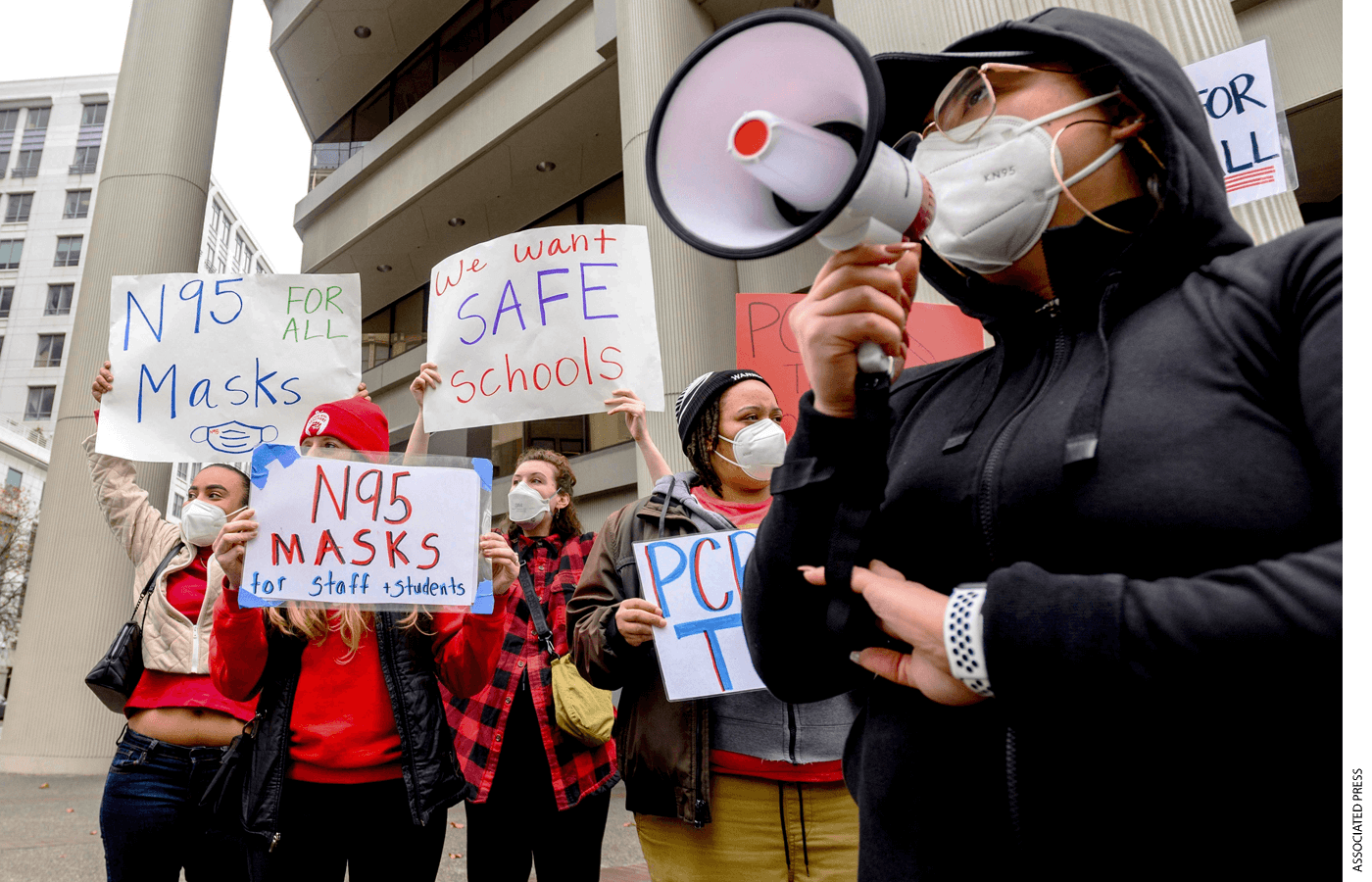
A decade or two ago, those in the education-reform business used to lament that education didn’t get the attention it deserved. Their faith that a star turn would energize school improvement played a big role in explaining the huge fuss education reformers made about the niche film Waiting for Superman in 2010.
Well, since that time, education has finally gotten its turn in the spotlight. During the Common Core brouhaha, in fights over school closure and masking, and in clashes over critical race theory and gender identity, schools have gotten a raft of media attention—though not of the kind that those wonks imagined.
Indeed, in 2022, school masking received more media attention than Ron DeSantis or quarterbacking icon Tom Brady (who retired, un-retired, got divorced, and had his worst season of the millennium). Given a changing media landscape, profound shifts in education, and polarizing public debates, it seems useful to step back and examine the extent and focus of media coverage.
What gets covered? What doesn’t? Does the coverage seem proportionate? Such a look can serve as a useful reality check: Is one’s particular sense of the public debate broadly accurate, or could it be distorted by echo chambers and the funhouse mirror of social media?
This all seems especially relevant after the pandemic. The past few years have seen extraordinary attention to schooling—featuring ferocious debates about school closures, masking, critical race theory, gender identity, school choice, and more. How much attention did these various topics actually garner? And how did the attention to pandemic-era issues stack up against that devoted to other 21st-century education developments?
To answer these questions, we examined the prominence of various topics over the past 20 years. The numbers for 2022 were collected between January 1 and October 31 and then prorated to estimate a full-year number. We used the search engine LexisNexis (a database of news articles from national and international media outlets) to identify the number of articles each year that mentioned each topic.
For those interested in the details: We used Lexis Nexis’ academic search engine Nexis Uni (formerly LexisNexis Academic), which offers access to 17,000 news, business, and legal sources. In all cases, we searched for articles in the LexisNexis category “Newspapers” and set the location as “United States-US.” Now, while such a search is comprehensive, it is not exhaustive. For example, blogs and some education-specific media (such as Education Week) are not included. These parameters give us confidence that the results are a pretty good gauge of attention across the broad sweep of journalistic coverage—rather than coverage in blogs or specialized outlets.
A few particular notes: To avoid jargon-induced confusion, we used full terms rather than acronyms (so we searched for “social and emotional learning” rather than “SEL” or “critical race theory” rather than “CRT”). To avoid confusing broader social debates with those more focused on schooling, we included the term “schools” when searching a non-education specific term like “diversity, equity, and inclusion.”
Covid-19 and Culture Clash
During the pandemic, which topics commanded the bulk of media attention? For starters, it can be striking to realize that topics which have been unavoidable during the pandemic and in its aftermath were wholly invisible just three years ago. Critical race theory, school masking, and remote learning combined received less than 500 media mentions in all of 2019. School masking alone received far more than that each week in 2022 (See Figure 1).
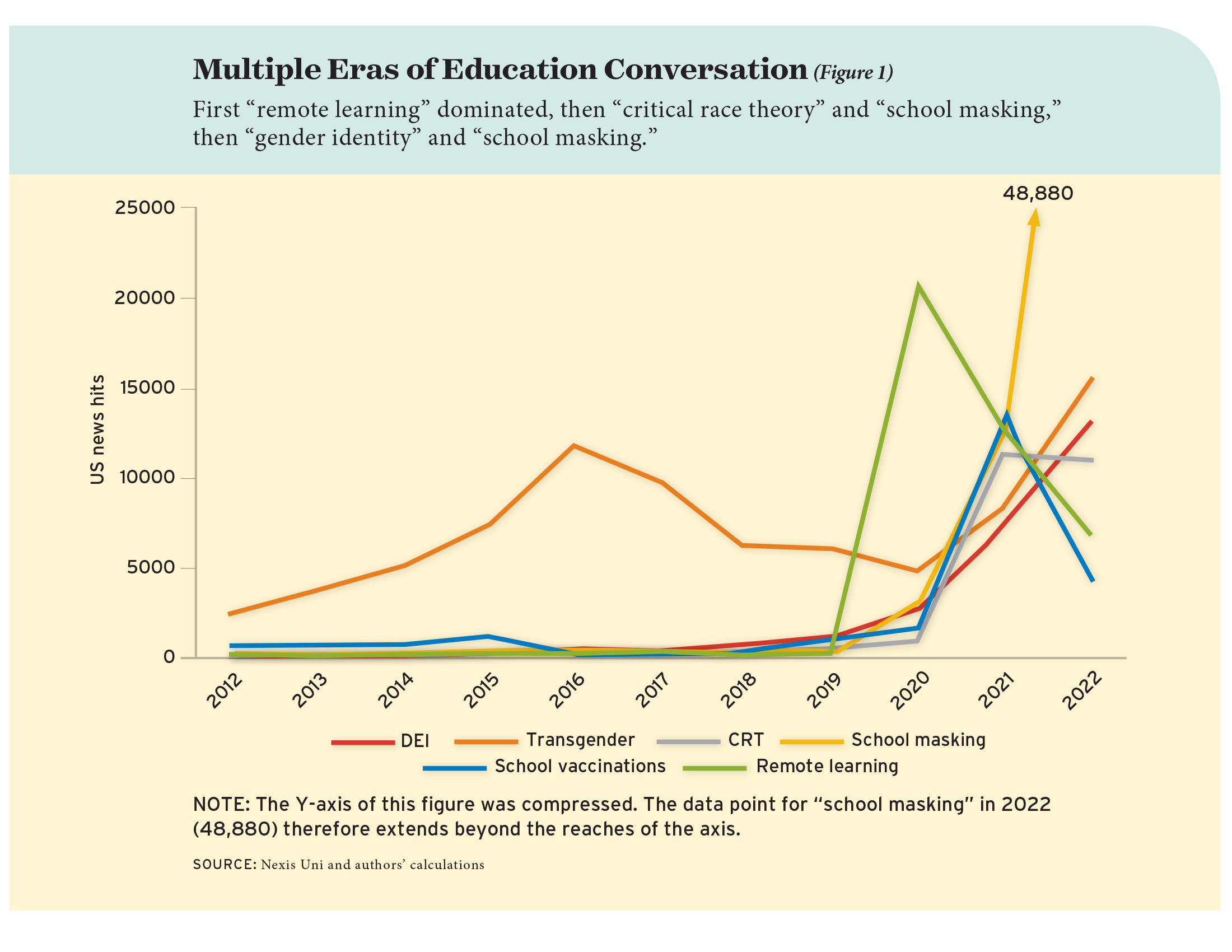
Starting in 2020, though, the cluster of issues around Covid-19 and our culture clashes catapulted into public view. In 2020, remote learning drew more than 20,000 media hits. School masking drew only a fraction of that attention, receiving almost 3,000 mentions. Meanwhile, attention to school vaccinations and critical race theory actually saw only modest increases. And then, in 2021, the culture clash took off, as the attention paid to diversity, equity, and inclusion tripled and that to critical race theory exploded more than tenfold.
By 2022, even though many states had dropped mask requirements in 2021 and most others did so in early 2022, masking drew 48,000 mentions—nearly four times as many as in 2021. It’s a figure that dwarfs every other topic. It’s not clear whether this was due to debates about dropping mask requirements or retrospective evaluations of the wisdom of masking.
Meanwhile, it can be surprising to note that other topics which have drawn much attention of late—including school-related vaccinations; issues related to transgender students; or diversity, equity, and inclusion—were already garnering substantial attention before 2020. The topic of transgender in schools received more than 5,000 mentions every year from 2015 to 2019. School vaccination received more than 1,000 mentions in 2019 and diversity, equity, and inclusion more than 2,000 that year.
Looking at 2019–2022, it’s as if America raced through four different eras in the span of 36 months: from a pre-Covid-19 order, to a world dominated by remote learning, to one focused on equal parts critical race theory and school masking, and finally to one dominated by school-masking and debates about gender identity.
School Choice
School choice has loomed large in the education conversation throughout the pandemic. Indeed, amidst public-school closures, the success of many private schools at staying open, the embrace of homeschooling, and the passage of a raft of state legislation, 2021 was dubbed “The Year of School Choice.” Given that school choice seemed omnipresent in the public discourse during the pandemic, we were curious to see whether the media coverage bore that impression out. Figure 2 shows the results.
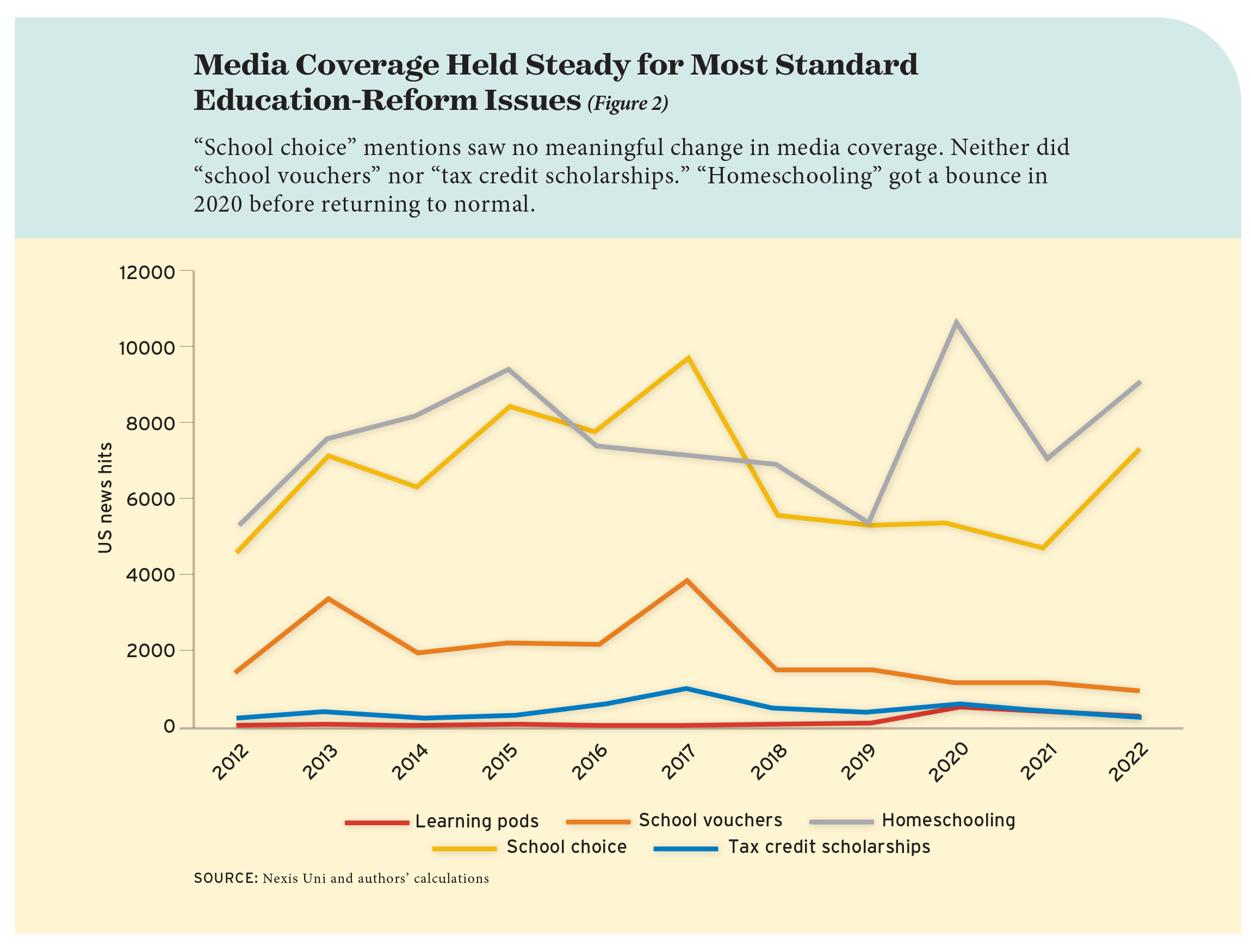
The most pandemic-specific school-choice innovation was probably “learning pods”—clusters of families which arranged for teachers to work with their children. For those who inhabit the world of education policy, it might seem like learning pods were a widely discussed phenomenon in the first year of the pandemic. Yet it turns out that learning pods never gathered more than scant attention—peaking at similar numbers as school vaccinations did each year in the decade preceding Covid-19.
Surprisingly, the pandemic wasn’t an especially high-profile time for school choice. “School choice” saw no meaningful change in media coverage during the pandemic from pre-2020, with the number of mentions actually dipping in both 2020 and 2021 and then returning to roughly the pre-pandemic norm in 2022. The same pattern applied to school vouchers and tax credit scholarships, while homeschooling saw a noticeable (but relatively short-lived) 2020 bounce.
The Eddies of School Reform
How did the K–12 coverage during the pandemic experience compare to what we’ve seen before? The pandemic seemed to elevate some education issues to unprecedented visibility. If we broaden the lens, what changes might we see in the swirling eddies of “school reform”?
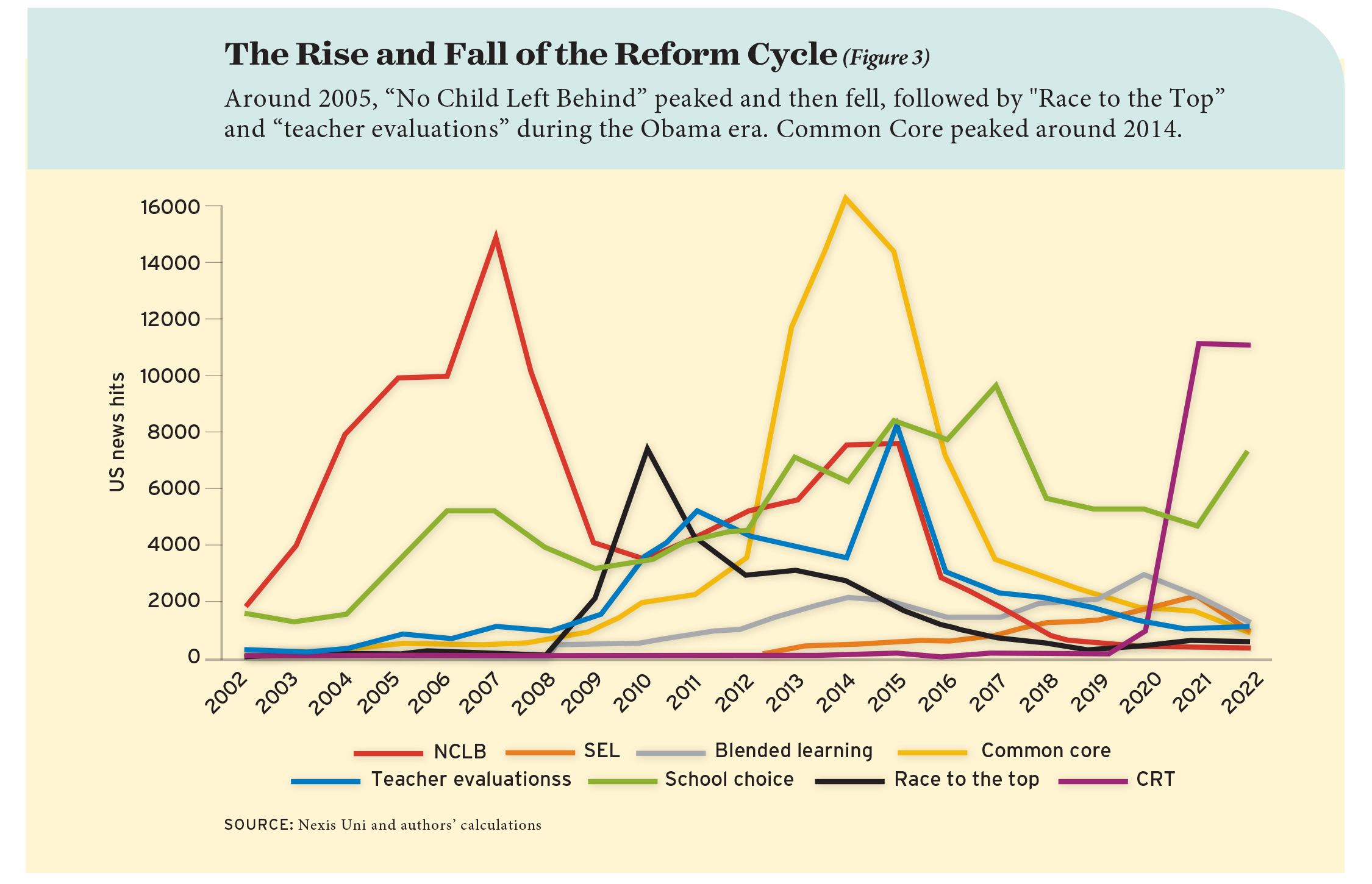
It turns out that the plight of 21st-century reform was impacted by the pandemic but less dramatically than we might have expected (See Figure 3). From 2020 to 2022, for instance, we saw topics of blended learning and social and emotional learning reaching new highs. However, those highs weren’t especially high. Blended learning reached 1,000 hits in 2012, topped 2,000 in 2019, peaked at nearly 3,000 in 2020, and then fell sharply to about 1,300 in 2022. Social and emotional learning exhibited a remarkably similar pattern. What explains the big declines in 2022, and whether those turn out to be blips or something more substantial, is a question worth exploring.
That ebb and flow of reform is a familiar pattern. If one examines Figure 3 as a whole, what leaps out is the rhythmic rise and fall of various reforms. The early years of the century saw a half-decade of steadily increasing attention to No Child Left Behind; as that started to recede, the twin Obama-era fascinations of Race to the Top and teacher evaluation came to the fore. And not long after that, the Common Core emerged as the dominant issue on the educational landscape.
Perhaps the one exception to the general pattern is school choice, which hasn’t had the clear rise and fall that characterizes most reforms. Rather, school choice consistently collected between 3,000 and 5,000 hits between 2005 and 2012 and between 5,000 and 10,000 between 2013 and 2020.
No Child Left Behind, Common Core, School Choice, and Critical Race Theory
Figure 4 offers a visual that may help to make sense of the often-messy ebbs and tides of early 21st-century school reform. It presents a handful of the most prominent school reforms, illustrating that it may make sense to think about the past few decades as defined by three (and a half) peaks.
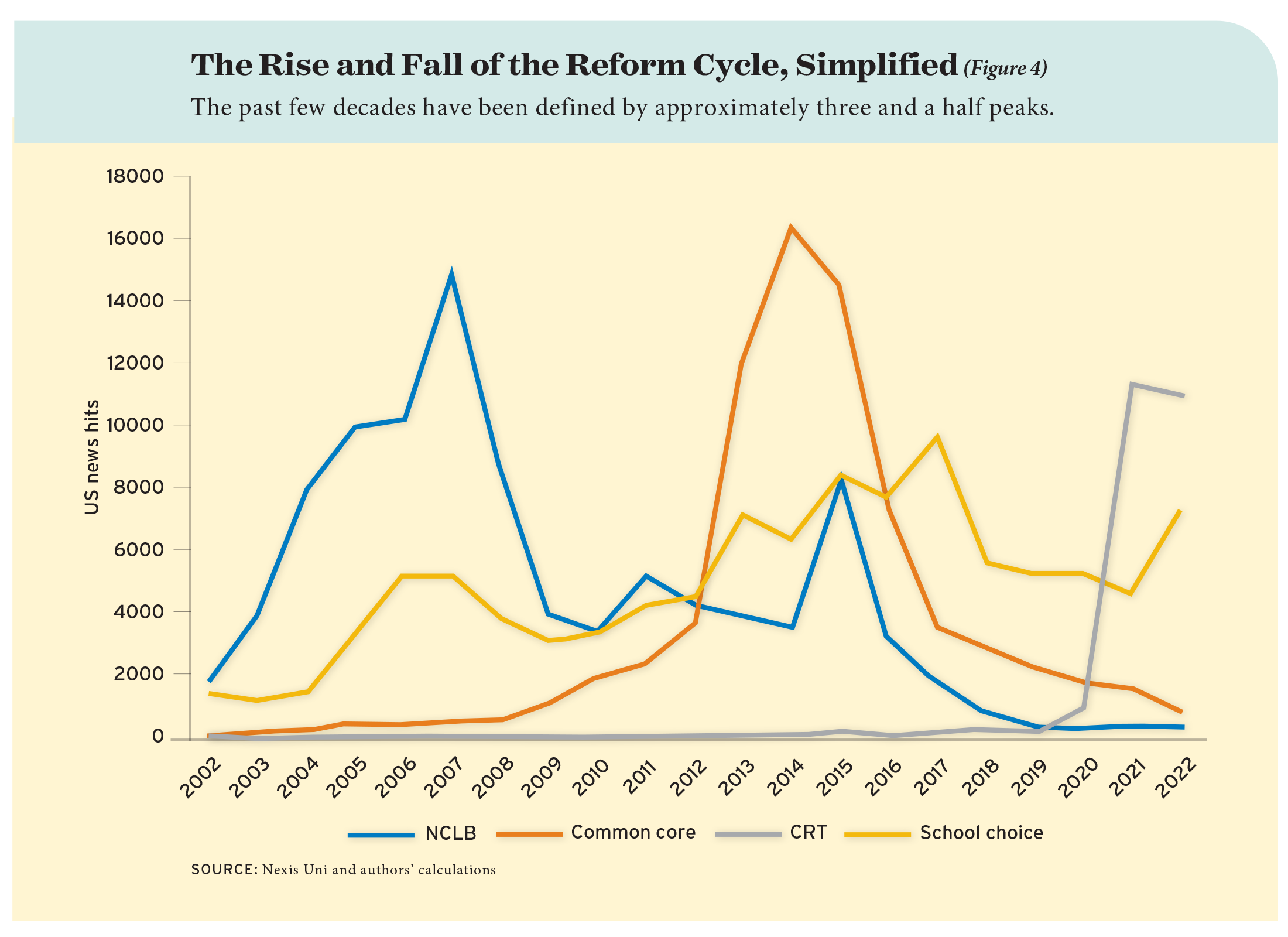
The first of these, spanning roughly the length of the Bush administration, was the decade-long rise and fall of No Child Left Behind. The second was the more rapid ascendance of the Common Core, with its heated debates and swift decline. That was followed by a school choice half-peak, when a dearth of other high-profile reforms and the efforts of Secretary of Education Betsy DeVos yielded several years when choice defined the landscape—albeit with about half the attention devoted to No Child Left Behind or the Common Core at their peaks. The third, during the pandemic, has been the explosive cultural clash about race-based curriculum and pedagogy, playing out under the banner of critical race theory.
This larger shift, from slow-moving policy debate to rapidly emerging cultural clashes seems to capture some fundamental dynamic at work in both education coverage and schools at large. It remains to be seen whether this is a temporary shift, brought on by social media and a polarized politics, or is something more permanent.
Ron DeSantis, Tom Brady, and School Masking
Finally, we really feel like we should show you the graphic we mentioned back at the start. We weren’t exaggerating when we noted that high-flying Florida governor Ron DeSantis and seven-time Super Bowl champion quarterback Tom Brady got less coverage than school masking this year. And, if one were to sum up the attention devoted to masking, critical race theory, transgender students and schools, blended learning, and social and emotional learning, one could conclude that education, in total, receives substantial attention.
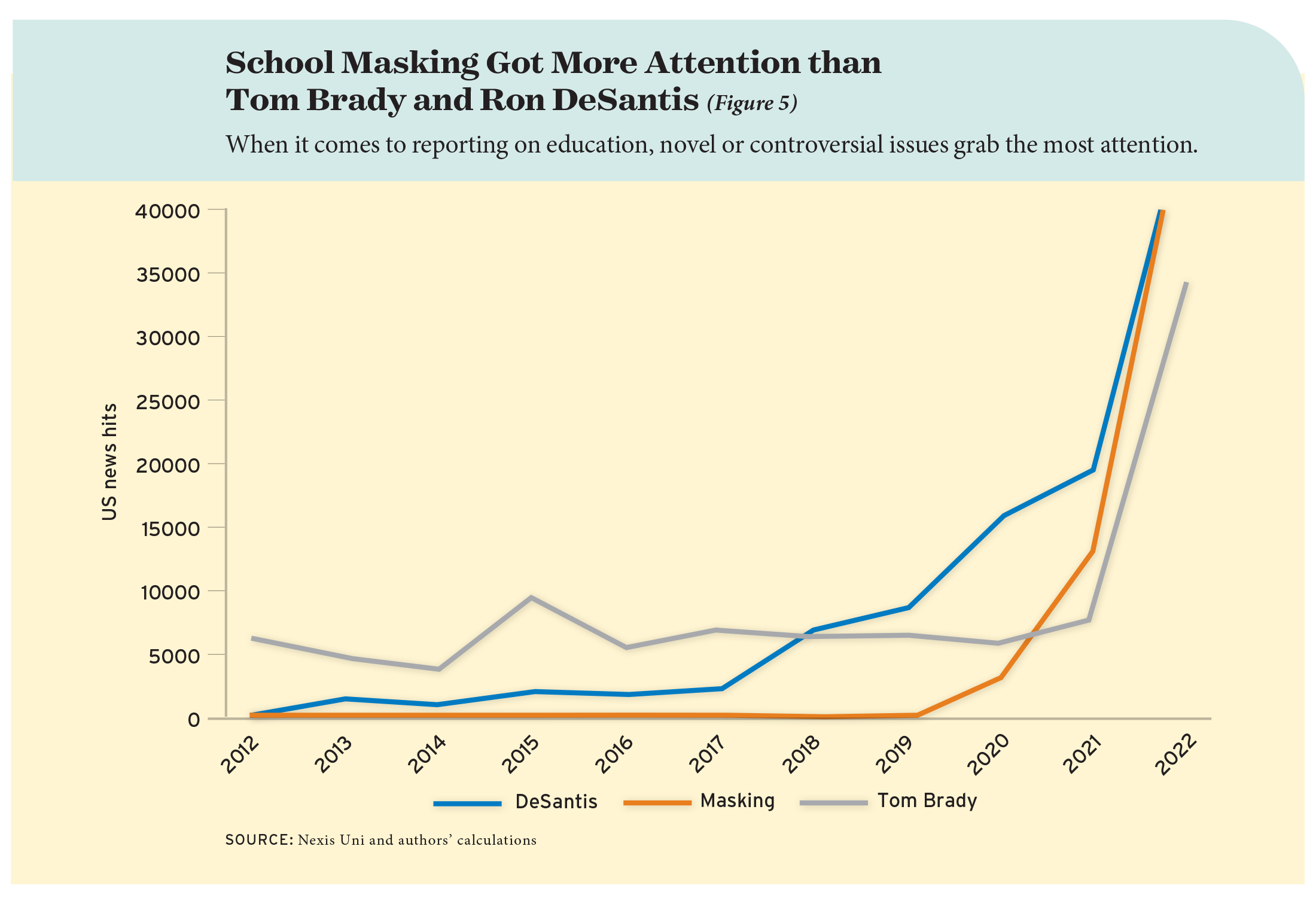
Now, there’s an important caveat here. For starters, those wishing for schools to get more media attention do well to note that the attention tends to focus on the dramatic and the controversial. In our experience, those urging more coverage tend to have in mind careful accounts of complex school-improvement strategies. A quick perusal here suggests that the things which grab media notice appear to be novel or controversial, which means that even extensive attention isn’t likely to yield much of that kind of coverage.
A larger point here may be that coverage is most likely when there’s a sense that the issues at stake have a direct impact on daily lives. Masking and vaccinations certainly fit that bill. Controversies over the Common Core or critical race theory raised real concerns among parents and educators, on both sides of the debate, that their students or their schools were going to be scarred by politically motivated adversaries.
Takeaways
Over the past decade, education has become a routine part of the public debate in a manner that once would have seemed difficult to imagine. Indeed, back in 2008, Brookings Institution scholars calculated that just 0.7 percent of national news coverage involved education. They lamented this state of affairs and argued that schools should get a lot more public attention. Well, when we contemplate the exhaustive coverage of school closures, Covid-19 interventions, and culture clashes, it’s a reminder to be careful what you wish for.
As we survey the results of this little analysis, at least three takeaways strike us.
The first is that coverage gravitates towards those things which have a real and immediate impact on families, communities, and educators. While this may seem blindingly obvious when written this way, it’s striking how frequently it’s been overlooked by education reformers intent on devising ways to promote more media coverage of esoteric initiatives or complex reform strategies.
A second is that it’s eye-opening to realize how some topics which have been ubiquitous during the pandemic were wholly invisible just three years ago. It’s a reminder of how rapidly a variety of high-profile reforms or issues have dominated and then departed the education landscape. That should be a caution for school leaders, funders, and advocates inclined to scramble to rethink their mission or vision in accord with the latest (but often short-lived) changed reality.
A third is that, outside of masking and school choice, there was pretty much an across-the-board decline in media attention to K–12 topics in 2022. As we look to 2023, with the pandemic behind us, attention ebbing with regard to things like blended learning and social and emotional learning, and a focus on some of the culture clashes appearing to have eased, we’ll see if the new year starts to look more like 2019—or if we’re off into a very different, post-pandemic era. Time will tell.
Frederick Hess is director of education policy studies at the American Enterprise Institute and an executive editor of Education Next. Ilana Ovental is a research assistant at the American Enterprise Institute.


